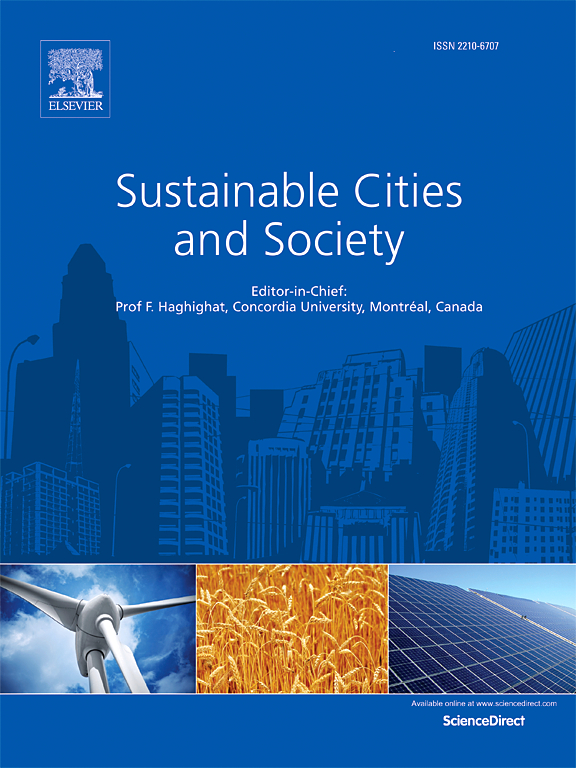基于街谷的上海高密度街区热岛实测及CFD模拟研究
IF 10.5
1区 工程技术
Q1 CONSTRUCTION & BUILDING TECHNOLOGY
引用次数: 0
摘要
城市热岛(UHI)对城市环境和居民的影响日益加剧,特别是在街区尺度上,引起了人们对热问题的重视。本文通过现场实测和模拟对上海典型地块进行了分析。首先,在夏季和冬季进行12天的野外测量,获取了热岛热岛的时空分布。城市平均热岛强度(UHII)夏季为3.19°C(白天2.25°C,夜间4.13°C),冬季为1.93°C(白天1.54°C,夜间2.33°C)。点间温差夏季最高可达10.8℃,冬季最高可达4.09℃,单功能街区温度波动幅度大于多功能街区。在此基础上,建立了UHII随太阳辐射强度(SRI)和风速变化的线性和曲线拟合方程。对于线性拟合,在夏季UHII中,SRI或风速的±10%变化导致±0.26°C或+ - 0.16°C的变化,在冬季UHII中导致±0.14°C或+ - 0.10°C的变化。对风向变化的定量分析表明,夏季高密度绿地或滨水区下风区UHII下降幅度高达91.61%。街道峡谷节点温度的多元回归分析表明,6个街区的拟合效果较好。该研究为城市热岛缓解和街区尺度规划提供了理论支持和参考。本文章由计算机程序翻译,如有差异,请以英文原文为准。
Field measurement and CFD simulation study on UHI in high-density blocks of Shanghai based on street canyons
The impact of urban heat island (UHI) on urban environments and residents has worsened, especially at the block-scale, drawing significant research attention to thermal issues. This study analyzes typical Shanghai blocks through field measurements and simulations. First, 12-day field measurements in summer and winter captured UHI spatiotemporal distribution. The average urban heat island intensity (UHII) was 3.19 °C in summer (daytime 2.25 °C, nighttime 4.13 °C) and 1.93 °C in winter (daytime 1.54 °C, nighttime 2.33 °C). The maximum temperature difference between points reached 10.8 °C in summer and 4.09 °C in winter, with greater temperature fluctuations in single-functional blocks than in multifunctional ones. Then, based on simulations, linear and curve fitting equations for UHII with changes in solar radiation intensity (SRI) or wind speed showed accurate results. For the linear fitting, a ± 10 % change in SRI or wind speed resulted in a ± 0.26 °C or ∓0.16 °C change in summer UHII, and a ± 0.14 °C or ∓0.10 °C in winter UHII. Quantitative analysis of wind direction changes showed that high-density areas downwind of green spaces or waterfronts saw summer UHII drop by up to 91.61 %. Multiple regression analysis of street canyon node temperatures showed good fits for six blocks. This study provides theoretical support and references for UHI mitigation and block-scale planning.
求助全文
通过发布文献求助,成功后即可免费获取论文全文。
去求助
来源期刊

Sustainable Cities and Society
Social Sciences-Geography, Planning and Development
CiteScore
22.00
自引率
13.70%
发文量
810
审稿时长
27 days
期刊介绍:
Sustainable Cities and Society (SCS) is an international journal that focuses on fundamental and applied research to promote environmentally sustainable and socially resilient cities. The journal welcomes cross-cutting, multi-disciplinary research in various areas, including:
1. Smart cities and resilient environments;
2. Alternative/clean energy sources, energy distribution, distributed energy generation, and energy demand reduction/management;
3. Monitoring and improving air quality in built environment and cities (e.g., healthy built environment and air quality management);
4. Energy efficient, low/zero carbon, and green buildings/communities;
5. Climate change mitigation and adaptation in urban environments;
6. Green infrastructure and BMPs;
7. Environmental Footprint accounting and management;
8. Urban agriculture and forestry;
9. ICT, smart grid and intelligent infrastructure;
10. Urban design/planning, regulations, legislation, certification, economics, and policy;
11. Social aspects, impacts and resiliency of cities;
12. Behavior monitoring, analysis and change within urban communities;
13. Health monitoring and improvement;
14. Nexus issues related to sustainable cities and societies;
15. Smart city governance;
16. Decision Support Systems for trade-off and uncertainty analysis for improved management of cities and society;
17. Big data, machine learning, and artificial intelligence applications and case studies;
18. Critical infrastructure protection, including security, privacy, forensics, and reliability issues of cyber-physical systems.
19. Water footprint reduction and urban water distribution, harvesting, treatment, reuse and management;
20. Waste reduction and recycling;
21. Wastewater collection, treatment and recycling;
22. Smart, clean and healthy transportation systems and infrastructure;
 求助内容:
求助内容: 应助结果提醒方式:
应助结果提醒方式:


